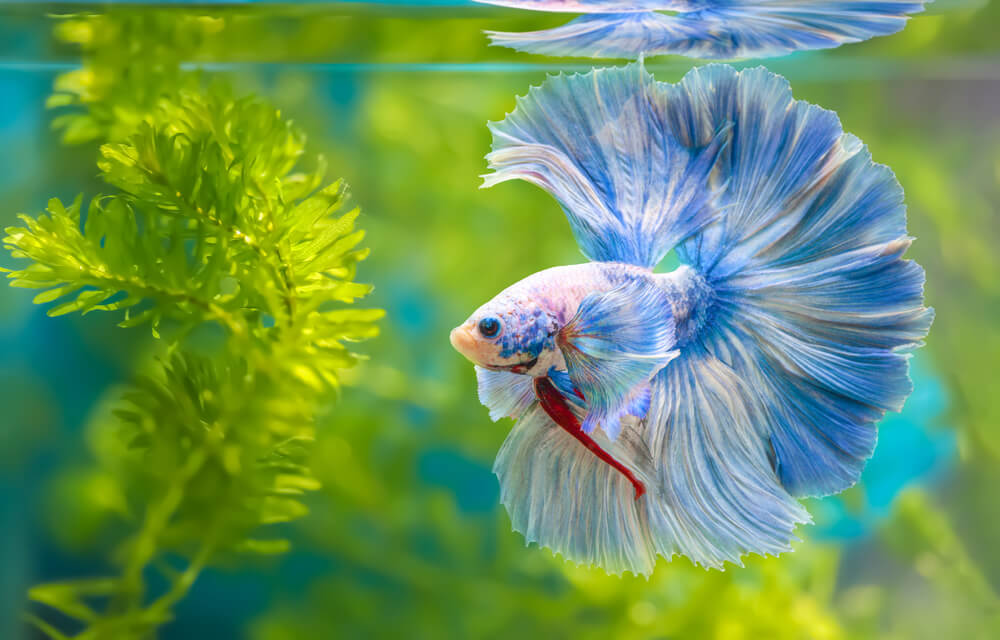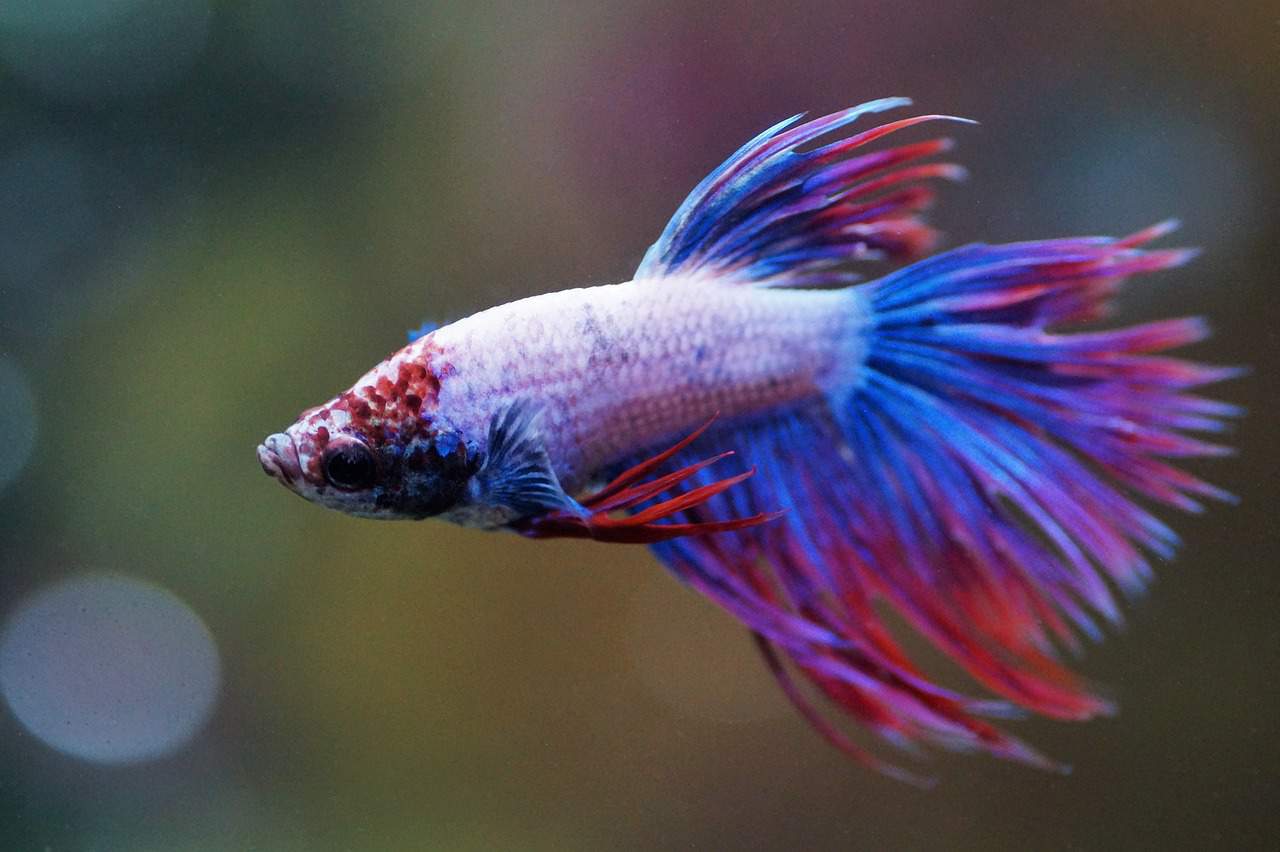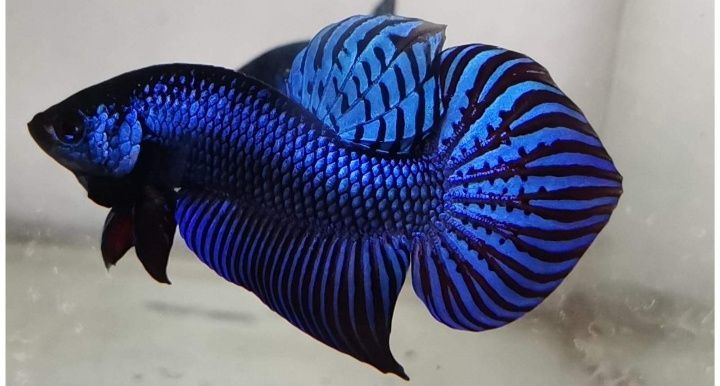Betta fish, also known as Siamese fighting fish, are a popular choice for freshwater aquariums due to their vibrant colors, various fin shapes, and relative ease of care. Over the years, these fish have been selectively bred, resulting in a wide variety of different-looking types of betta fish.
In this article, we will explore nine types of fighter fish, categorized by their fin type, pattern, and color. While new types of bettas may occasionally emerge, we will cover the majority of these fascinating and beautiful fish, providing images for illustration.
You are reading: 9 Types Of Fighter Fish

9 Types Of Fighter Fish
Veiltail Betta

Veiltail Betta fish, also known as VT Betta, are a popular and vibrant choice for freshwater aquariums. They are characterized by their long, swooping, and flowing tails that droop from just behind the fin (caudal peduncle). This tail type gene is dominant, making them one of the easiest Betta varieties to breed.
Veiltails come in a wide variety of color combinations, with males being more striking and beautiful, while females have less bright coloration and shorter tails and fins.
These Betta fish are well-suited for both novice and experienced fish keepers. They are easier to breed than other varieties within the Betta family (Osphronemidae).
Veiltails are known for their outgoing and friendly personalities, often wiggling their tails in the presence of their owners and moving around the tank to get a better view of their keepers. Unlike some other Betta types, Veiltails are docile and peaceful, with calm and pleasant temperaments.
In terms of tank compatibility, Veiltails are usually more docile and peaceful, making them suitable tank mates for guppies, kuhli loaches, ghost shrimp, and cory fish (any schooling or community fish).
However, it’s important to avoid housing them with aggressive or fin-nipping species, as this can cause stress and potential damage to their delicate fins.
While the popularity of Veiltail Bettas has somewhat waned in recent years due to the introduction of more “fancy betta” tail types, their ease of breeding and availability still make them sought after by aquarium enthusiasts. These fish are considered common by breeders, and there are no longer categories for showing Veiltail Bettas competitively.
However, among betta hobbyists, there is a strong resistance to let this tail type disappear, as many loyal keepers love their Veiltails for their pleasant demeanor and overall health.
Crowntail Betta
Crowntail Betta fish, also known as CT Betta, are a unique and popular choice for freshwater aquariums. Hailing from shallow rivers and rice paddies throughout Southeast Asia, they are one of the world’s most sought-after pet fish species.
These fish are known for their long, flowing fins with spiky rays extending from their tails, which give them their distinctive crown-like appearance.
One of the main reasons for the popularity of Crowntail Bettas is their stunning caudal fins, which come in a wide variety of colors, including various reds, blues, oranges, yellows, greens, blacks, and whites.
The most common colors are red and blue. Males typically have more vibrant and striking colors than females, making them the preferred choice for many aquarium enthusiasts.
In terms of care, Crowntail Bettas are relatively easy to maintain, making them suitable for beginner aquarists. They have a peaceful temperament and can be housed with other non-aggressive fish species, such as guppies, kuhli loaches, ghost shrimp, and cory fish.
However, it’s important to avoid housing them with aggressive or fin-nipping species, as this can cause stress and potential damage to their delicate fins.
These fish are best kept in a well-maintained aquarium with a temperature range of 76-82°F (24-28°C) and a pH level between 6.5 and 7.5. They prefer a diet of high-quality betta pellets, supplemented with occasional treats of frozen or live foods, such as bloodworms or brine shrimp.
Overall, Crowntail Bettas are a popular choice for both their unique appearance and ease of care, making them a great ornamental addition to any freshwater aquarium. Whether you’re a beginner or an experienced fish keeper, these beautiful and fascinating fish are sure to captivate and delight you with their graceful presence.
Halfmoon Betta
Halfmoon Betta fish, also known as HM Betta, are a popular and vibrant choice for freshwater aquariums. These fish are native to the tropical regions of Southeast Asia and are known for their vibrant colors, long flowing fins, and unique half-moon-shaped tails.
When fully open, their tail fins can span from 170° to a perfect 180°, resembling a half-moon.
One of the main reasons for the popularity of Halfmoon Bettas is their stunning and diverse coloration, ranging from deep blues and bright reds to shades of purple and orange. Males typically have more vibrant and striking colors than females, making them the preferred choice for many aquarium enthusiasts.
In terms of care, Halfmoon Bettas are relatively easy to maintain, making them suitable for both beginner and experienced fish keepers. They are tropical fish and thrive in warm water environments with temperatures ranging from 72°F to 81°F (26-28°C).
These fish are also known for their energetic nature, constantly moving around their territory, and are best housed in larger aquariums to accommodate their active behavior.
Read more : Discover 13 Animals Roaming Atop Missouris Tallest Mountain
Halfmoon Bettas are known for their territorial and aggressive nature, often becoming hostile towards other fish species. They can even feel threatened when their owners approach the tank, displaying intimidating behaviors such as fanning out their fins and puffing out their gills and chin. Therefore, it’s important to house them alone or with non-aggressive tank mates to avoid conflicts and stress.
With their dazzling colors and unique half-moon tails, Halfmoon Bettas are a stunning addition to any freshwater aquarium. Their ease of care and vibrant personalities make them a favorite among fish enthusiasts looking to add some vibrancy and beauty to their aquatic setups.
Rosetail Betta

Rosetail Betta fish, also known as Rose Petal Betta, are a unique and controversial variant of the Halfmoon Betta. They are bred to have a tail with a full 180° spread, similar to the Halfmoon, but with extra branching in the fin rays, especially on the caudal fin. This excessive branching gives the tail a ruffled or rose-like appearance, hence the name “Rosetail”.
One of the main reasons for the controversy surrounding Rosetail Bettas is their excessive finnage, which can lead to various health issues. The excessive branching and overlapping of the fins can make it difficult for the fish to swim properly, causing them to tire easily and become more susceptible to fin rot and other infections.
Additionally, their long, striking fins are more prone to tearing and damage, requiring extra care and maintenance.
In terms of care, Rosetail Bettas require a well-maintained aquarium with a temperature range of 76-82°F (24-28°C) and a pH level between 6.5 and 7.5, similar to other Betta varieties.
They should be housed alone or with non-aggressive tank mates to avoid conflicts and stress. Due to their delicate fins and potential health issues, Rosetail Bettas are not recommended for beginner fish keepers.
Despite the controversy surrounding their health and care requirements, Rosetail Bettas are still sought after by some aquarium enthusiasts for their unique and striking appearance.
However, it’s important to consider the potential challenges and risks associated with keeping these fish before adding them to your aquarium. If you decide to keep a Rosetail Betta, be prepared to provide the extra care and attention they need to thrive in your aquatic setup.
Double Tail Betta
Double Tail Betta fish, also known as DT Betta, are a unique and fascinating variant of the Betta splendens species. They are characterized by their two distinct caudal lobes, which give them a unique and striking appearance. This tail type is the result of a genetic mutation that causes the dorsal fin to be equal in length to the anal fin, resulting in two tails.
One of the main reasons for the popularity of Double Tail Bettas is their unique and striking appearance, which comes in a range of different colors and patterns. They are also relatively easy to care for, making them suitable for both beginner and experienced fish keepers.
These fish are carnivorous and require a diet of high-quality betta pellets, supplemented with occasional treats of frozen or live foods, such as bloodworms or brine shrimp.
In terms of tank compatibility, Double Tail Bettas are known for their semi-aggressive temperament and should be housed alone or with non-aggressive tank mates to avoid conflicts and stress. They prefer a well-maintained aquarium with a temperature range of 76-82°F (24-28°C) and a pH level between 6.5 and 7.5.
Overall, Double Tail Bettas are a unique and fascinating addition to any freshwater aquarium. Their striking appearance and ease of care make them a popular choice among aquarium enthusiasts looking to add some vibrancy and beauty to their aquatic setups.
Plakat Betta
Plakat Betta fish, also known as Siamese fighting fish, are a unique variant of the Betta Fish species. They are characterized by their short, stubby tails, which set them apart from other Betta varieties. Plakat Bettas are native to shallow waters filled with plenty of hiding spaces, and they appreciate having numerous resting options in their aquariums.
One of the main reasons for the popularity of Plakat Bettas is their vibrant colors and patterns, which come in a wide range of options. They are relatively easy to care for, making them suitable for both beginner and experienced fish keepers.
These fish are carnivorous and do not require plant matter in their diet. In the wild, they consume marine proteins and insects as their primary food sources.
In terms of tank compatibility, Plakat Bettas are known for their aggressive nature and should be housed alone or with non-aggressive tank mates to avoid conflicts and stress. They prefer a well-maintained aquarium with a temperature range of 72-82°F (22-28°C) and a pH level between 6.5 and 7.5.
Overall, Plakat Bettas are a unique and fascinating addition to any freshwater aquarium. Their short, stubby tails and vibrant colors make them a popular choice among aquarium enthusiasts looking to add some vibrancy and beauty to their aquatic setups. If you decide to keep a Plakat Betta, be prepared to provide the extra care and attention they need to thrive in your aquarium.
Delta Tail Betta

Delta Tail Betta fish, also known as DT Betta, are a unique and fascinating variant of the Betta Fish species. They are named after their triangular-shaped tail, which forms a triangle shape when the fish flares its fins.
The tail narrows near the body and extends out in a rounded edge at the end. Delta Tail Bettas come in a wide range of colors and patterns, making them a popular choice among aquarium enthusiasts.
In terms of care, Delta Tail Bettas are relatively easy to maintain, making them suitable for both beginner and experienced fish keepers. They prefer a well-maintained aquarium with a temperature range of 76-82°F (24-28°C) and a pH level between 6.5 and 7.5. These fish are carnivorous and require a diet of high-quality betta pellets, supplemented with occasional treats of frozen or live foods, such as bloodworms or brine shrimp.
Delta Tail Bettas are known for their semi-aggressive temperament and should be housed alone or with non-aggressive tank mates to avoid conflicts and stress. They prefer a spacious aquarium with plenty of hiding places and resting options.
Read more : 12 Types Of Triggerfish Ranked By Size
Unlike some other Betta types, Delta Tail Bettas are docile and peaceful, with calm and pleasant temperaments.
Overall, Delta Tail Bettas are a unique and fascinating addition to any freshwater aquarium. Their striking appearance and ease of care make them a popular choice among aquarium enthusiasts looking to add some vibrancy and beauty to their aquatic setups.
Super Delta Betta
Super Delta Betta fish, also known as SD Betta, are a unique and fascinating variant of the Betta Fish species. They are named after their tail shape, which is similar to the Delta Betta but with a wider flare when fully extended. The tail of a Super Delta Betta can fan between 120°-160° when flared, giving them a more impressive display than the standard Delta Betta.
One of the main reasons for the popularity of Super Delta Bettas is their vibrant colors and patterns, which come in a wide range of options. They are relatively easy to care for, making them suitable for both beginner and experienced fish keepers.
These fish are carnivorous and require a diet of high-quality betta pellets, supplemented with occasional treats of frozen or live foods, such as bloodworms or brine shrimp.
In terms of tank compatibility, Super Delta Bettas are known for their semi-aggressive temperament and should be housed alone or with non-aggressive tank mates to avoid conflicts and stress. They prefer a well-maintained aquarium with a temperature range of 76-82°F (24-28°C) and a pH level between 6.5 and 7.5.
Overall, Super Delta Bettas are a unique and fascinating addition to any freshwater aquarium. Their impressive tail flare and vibrant colors make them a popular choice among aquarium enthusiasts looking to add some vibrancy and beauty to their aquatic setups.
If you decide to keep a Super Delta Betta, be prepared to provide the extra care and attention they need to thrive in your aquarium.
Spade Tail Betta

Spade Tail Betta fish, also known as ST Betta, are a unique and fascinating variant of the Betta Fish species. They are named after their tail shape, which resembles a spade or shovel, with a wide base that narrows to a delicate point.
While they were more easily found in the early 1990s, Spade Tail Bettas are not as common in the aquarium trade today.
One of the main reasons for the popularity of Spade Tail Bettas is their unique and beautiful tail shape, which sets them apart from other Betta varieties. They come in a wide range of colors and patterns, making them a sought-after choice among aquarium enthusiasts.
In terms of care, Spade Tail Bettas are relatively easy to maintain, making them suitable for both beginner and experienced fish keepers. They prefer a well-maintained aquarium with a temperature range of 76-82°F (24-28°C) and a pH level between 6.5 and 7.5.
These fish are carnivorous and require a diet of high-quality betta pellets, supplemented with occasional treats of frozen or live foods, such as bloodworms or brine shrimp.
Spade Tail Bettas are known for their semi-aggressive temperament and should be housed alone or with non-aggressive tank mates to avoid conflicts and stress. They prefer a spacious aquarium with plenty of hiding places and resting options.
Overall, Spade Tail Bettas are a unique and fascinating addition to any freshwater aquarium. Their distinctive tail shape and vibrant colors make them a popular choice among aquarium enthusiasts looking to add some elegance and beauty to their aquatic setups. If you decide to keep a Spade Tail Betta, be prepared to provide the extra care and attention they need to thrive in your aquarium.
FAQS
1. Can you keep male and female Betta fish together?
No, it is not recommended to keep male and female Betta fish together, as they are known for their aggressive nature and may fight, leading to injury or even death.
2. How do you stop Betta fish from fighting?
To prevent Betta fish from fighting, it is essential to provide each fish with its own space. Keeping them in separate tanks or divided tanks can help avoid conflicts.
3. How do you tell the difference between a male and female Betta fish?
Male Betta fish are typically more vibrant in color, have longer fins, and display a more aggressive behavior. Female Betta fish, on the other hand, have shorter fins and are less colorful.
4. What is the origin of Betta fish?
Betta fish, also known as Siamese fighting fish, are native to Southeast Asia. The most well-known species is Betta splendens, but the genus Betta contains more than 73 recognized species.
5. What are some suitable tank mates for Betta fish?
Betta fish are best kept alone or with non-aggressive tank mates, such as small, peaceful fish or invertebrates like snails or shrimp. Avoid keeping them with other Betta fish or fin-nipping species.
6. How should I feed my Betta fish?
Betta fish are carnivorous and should be fed a diet of high-quality Betta pellets, supplemented with occasional treats of frozen or live foods, such as bloodworms or brine shrimp.
7. What is a Plakat Betta fish?
The Plakat Betta fish is a short-finned variety that was bred for fighting. They often have a stronger body and jaw than other types, like the Veil Tail.
8. Can Betta fish be bred in a home aquarium?
Yes, Betta fish can be bred in a home aquarium. However, before breeding, the fish must be conditioned by feeding them high-quality foods, including live or frozen foods.
9. How should I care for my Betta fish’s tank?
Betta fish prefer a well-maintained aquarium with a temperature range of 76-82°F (24-28°C) and a pH level between 6.5 and 7.5. They also need a spacious tank with plenty of hiding places and resting options.
Source: https://petstutorial.com
Category: Animals










